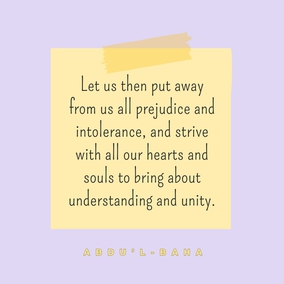The views expressed in our content reflect individual perspectives and do not represent the authoritative views of the Baha'i Faith.
It can be very challenging at first to reconcile Baha’u’llah’s assertion of the unity of religions with the apparent variations between them.
Baha’u’llah attributes the differences between the divinely revealed religions to two essential causes: First, each messenger of God, while affirming certain basic truths already revealed by other prophets of God, also brings specific laws and teachings necessary for the time in which he lives.
School provides an analogy that is useful for explaining this process. Humanity, progressing from one grade to the next, receives different teachers who deliver different lessons. Each grade, or stage of progress, rests upon the previous one, thereby affirming what has already been learned. Yet new lessons are also introduced that might seem to differ from what was taught before. In one grade it might be necessary for the pupils to undertake specific exercises and drills, whereas at a later time they are no longer necessary.
Second, the followers of previous religions, either through ignorance or corruption, have always misunderstood to some extent the meanings of the past teachings. Rituals, superstitions, and spurious beliefs are added to the religions, thereby enhancing their apparent differences. This problem is compounded by strong attachments to tradition that prevent people from investigating the truth of matters.
It is relatively easy to imagine Judaism, Christianity, Islam, and the Baha’i Faith as part of a continuum, because their principles and cultures of origin are so similar. Other religions, such as Buddhism and Hinduism, whose original founders were also manifestations of God, pose a bigger challenge. These religions seem to teach messages that differ vastly both from each other and from those of Judaism, Christianity, Islam, and the Baha’i Faith. However, it is probable that Buddhism and Hinduism have become so altered over the years that they have lost some of their original concepts. Consideration must also be given to the fact that the founders of Buddhism and Hinduism appeared in vastly different cultural milieus that may have required different points of emphasis.
Also, major segments of the Eastern religions, like the Judeo-Christian-Islamic traditions, anticipate a World Redeemer and an era of peace. Shoghi Effendi wrote:
To His Dispensation the sacred books of the followers of Zoroaster had referred as that in which the sun must needs be brought to a standstill for no less than one whole month. To Him Zoroaster must have alluded when, according to tradition, He foretold that a period of three thousand years of conflict and contention must needs precede the advent of the World-Savior Shah-Bahram, Who would triumph over Ahriman and usher in an era of blessedness and peace.
He alone is meant by the prophecy attributed to Gautama Buddha Himself, that “a Buddha named Maitreye, the Buddha of universal fellowship” should, in the fullness of time, arise and reveal “His boundless glory.” To Him the Bhagavad-Gita of the Hindus had referred as the “Most Great Spirit,” the “Tenth Avatar,” the “Immaculate Manifestation of Krishna.” – God Passes By, p. 95.
Abdu’l-Baha emphasized that the religions are all fundamentally in agreement, yet differences have arisen due to human limitations and not the inherent truths that these religions contain:
Therefore, if the religions investigate reality and seek the essential truth of their own foundations, they will agree and no difference will be found. But inasmuch as religions are submerged in dogmatic imitations, forsaking the original foundations, and as imitations differ widely, therefore, the religions are divergent and antagonistic. These imitations may be likened to clouds which obscure the sunrise; but reality is the sun. If the clouds disperse, the Sun of Reality shines upon all, and no difference of vision will exist. The religions will then agree, for fundamentally they are the same. The subject is one, but predicates are many. – The Promulgation of Universal Peace, p. 126.
















Comments
Sign in or create an account
Continue with Googleor